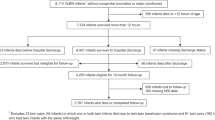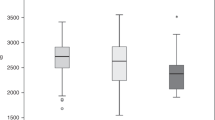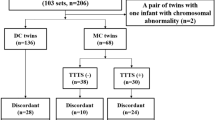Abstract
Objective:
Twins in developing countries may be disadvantaged due to their small size at birth, compromised nutrition and high infection risk. Although twinning is common in Africa, there are few longitudinal studies of growth and morbidity in this high-risk group. The aim of the present paper was to describe growth and morbidity of Malawian twins compared to singletons.
Methods:
Morbidity episodes were recorded at 4 weekly intervals and at extra visits made to health centres for illness. Weight, length, head and arm circumference were recorded at birth and weight, length and MUAC at 4 weekly intervals to 52 weeks of age.
Results:
Twins showed reduced fetal growth compared to singletons, with increasing fall-off in percentiles from 33 weeks gestation. Infant growth percentiles for twins were below those for singletons at all ages, but showed no fall-off from singleton percentile values. There were no differences in morbidity incidence during infancy between twins and singletons.
Conclusion:
Malawian twins showed no catch-up growth during infancy, their smaller size was not associated with higher morbidity incidence compared to singletons.
This is a preview of subscription content, access via your institution
Access options
Subscribe to this journal
Receive 12 print issues and online access
$259.00 per year
only $21.58 per issue
Buy this article
- Purchase on Springer Link
- Instant access to full article PDF
Prices may be subject to local taxes which are calculated during checkout



Similar content being viewed by others
References
Aslan H, Gul A, Cebeci A, Polat I, Ceylan Y (2004). The outcome of twin pregnancies complicated by single fetal death after 20 weeks gestation. Twin Res 7, 1–4.
Ayatollahi SM (2003). Sizes and obesity pattern of south Iranian adolescent females. Ann Hum Biol 30, 191–202.
Beggs CB, Noakes CJ, Sleigh PA, Fletcher LA, Siddiqi K (2003). The transmission of tuberculosis in confined spaces: an analytical review of alternative epidemiological models. Int J Tuberc Lung Dis 7, 1015–1026.
Brabin BJ, Maxwell S, Chimsuku L, Verhoeff F, van der Kaay H, Broadhead R et al. (1993). A study of the consequences of malaria infection in pregnant women and their infants. Parassitologia 35 (suppl), 9–11.
Buckler JMH, Green M (1994). Birth weight and head circumference standards for English twins. Arch Dis Child 71, 516–521.
Chappel TJH (1974). The Yoruba cult of twins in historical perspective. Africa 44, 250–265.
Cole TJ (1988). Fitting smoothed centile curves to reference data. J R Statist Soc A 151 (part 3), 385–418.
Cole TJ (1989). Using the LMS method to measure skewness in the NCHS and Dutch national height standards. Ann Hum Biol 16, 407–419.
Cole TJ (1990). The LMS method for constructing normalised growth standards. Eur J Clin Nutr 44, 45–60.
Feachem RG, Koblinsky MA (1984). Interventions for the control of diarrhoeal diseases among young children: promotion of breast-feeding. Bull World Health Organ 62, 271–291.
Hall JG (2003). Twinning. Lancet 362, 735–743.
Harrison K, Rossiter CE (1985). Multiple pregnancy. Br J Obs Gynaecol 92 (Suppl 5), 49–60.
Jaffar S, Jepson A, Leach A, Greenwood A, Whittle H, Greenwood B (1998). Causes of mortality in twins in a rural region of The Gambia, west Africa. Ann Trop Paediatr 18, 231–238.
Justesen A, Kunst A (2000). Postneonatal and child mortality among twins in southern and eastern Africa. Int J Epidemiol 29, 678–683.
Kahn B, Lumey LH, Zybert PA, Lorenz JM, Cleary-Goldman J, D'Alton ME et al. (2003). Prospective risk of fetal death in singleton, twin, and triplet gestations: implications for practice. Obstet Gynecol 102, 685–692.
Kalanda BF, van Burren S, Verhoeff FH, Brabin BJ (2005a). Anthropometry of fetal growth in rural Malawi in relation to maternal malaria and HIV status. Arch Dis Child Fetal Neonatal edn 90, F161–F162.
Kalanda BF, Verhoeff FH, Brabin BJ (2005b). Fetal growth on weight, length, head and arm circumferences and body mass index estimated for Malawian live births from 30 to 42 weeks gestation. Ann Hum Biol 32, 639–649.
Lantz M, Chez RA, Rodriguez A, Porter KB (1996). Maternal weight gain patterns and birth weight outcome in twin gestation. Obstet Gynecol 87, 551–556.
Leveno KJ, Quirk JG, Whalley PJ, Herbert WN, Trubey R (1984). Fetal lung maturation in twin gestation. Am J Obstet Gynecol 148, 405–411.
Luke B, Gillespie B, Min SJ, Avni M, Witter FR, O’Sullivan MJ (1997). Critical periods of maternal weight gain: effect on twin birth weight. Am J Obstet Gynecol 177, 1055–1062.
Luke B, Hediger ML, Nugent C, Newman RB, Mauldin JG, Witter FR et al. (2003). Body mass index-specific weight gains associated with optimal birth weights in twin pregnancies. J Reprod Med 48, 217–224.
Luke B, Min SJ, Gillespie B, Avin M, Witter FR, Newman RB et al. (1998). The importance of early weight gain in the intrauterine growth and birth weight of infants. Am J Obstet Gynecol 179, 1155–1161.
Luke B, Witter FR, Abbey H, Feng T, Namnoum AB, Paige DM et al. (1991). Gestational age-specific birthweights of twins versus singletons. Acta Genet Med Gemellol (Roma) 40, 69–76.
Marivate M, Norman RJ (1982). Twins. Clin Obstet Gynaecol 9, 723–743.
McKeown T, Record RG (1953). The influence of placental size on foetal growth in man with special reference to multiple pregnancy. J Endocr 9, 418–426.
Naeye RL (1964). The fetal and neonatal development of twins. Pediatrics 33, 546–553.
National Statistical Office (NSO) (1998). Malawi Population and Housing Census. Summary of Final Results, vol. 1, Zomba, Malawi.
Neale MC, McArdle JJ (2000). Structured latent growth curves for twin data. Twin Res 3, 165–177.
Niknafs P, Sibbald J (2001). Accuracy of single ultrasound parameters in detection of fetal growth restriction. Am J Perinatol 18, 325–334.
Ogden C, Kuczmarski RJ, Flegal KM, Mei Z, Guo S, Wei R et al. (2002). Centers for Disease Control and Prevention 2000 growth charts for the United States: improvements to the 1977 National. Center for Health Statistics version. Pediatrics 109, 45–60.
Ohel G, Granat M, Zeevi D (1987). Advanced ultrasonic placental maturation in twin pregnancies. Am J Obstet Gynecol 156, 76–78.
Sonntag J, Waltz S, Schollmeyer T, Schuppler U, Schroder H, Weisner D (1996). Morbidity and mortality of discordant twins up to 34 weeks of gestational age. Eur J Pediatr 155, 224–229.
Sugar Co-operation of Malawi (SUCOMA) (1995). Meteorological Data. Nchalo, 1993–1994.
Taylor M, Fisk N (2000). Multiple pregnancy. Obstet Gynaecol 2, 4–10.
Van der mei J, Heijstra T, Boersma ER (2003). Growth patterns and survival rates of twins in a rural area of Ghana: a follow-up study from birth to adulthood. Ann Trop Paediatr 23, 107–120.
Verhoeff FH, Brabin BJ, Chimsuku L, Kazembe P, Broadhead RL (1999). Malaria in pregnancy and its consequences for the infant in rural Malawi. Ann Trop Med Parasitol 93, S25–S33.
Verhoeff FH, Brabin BJ, van Buuren S, Chimsuku L, Kazembe P, Wit JM et al. (2001). An analysis of intra-uterine growth retardation in rural Malawi. Eur J Clin Nutr 55, 682–689.
Verhoeff FH, le Cessie S, Kalanda BF, Kazembe PN, Broadhead RL, Brabin BJ (2004). Post-neonatal infant mortality in Malawi: the importance of maternal health. Ann Trop Paediatr 24, 161–169.
Verhoeff FH, Milligan P, Brabin BJ, Mlanga S, Nakoma V (1997). Gestational age assessment by nurses in a developing country using the Ballard method, external criteria only. Ann Trop Paediat 17, 333–342.
Waterlow JC, Buzina R, Keller W, Lane JM, Nichaman MZ, Tanner JM (1977). The presentation and use of height and weight data for comparing the nutritional status of groups of children under the age of 10 year. Bull World Health Organ 55, 489–498.
Wimalasundera RC, Trew G, Fisk NM (2003). Reducing the incidence of twins and triplets. Best Pract Res Clin Obstet Gynaecol 17, 309–329.
Wolf EJ, Vintzileos AM, Rosenkrantz TS, Rodis JF, Lettieri L, Mallozzi A (1992). A comparison of pre-discharge survival and morbidity in singleton and twin very low birth weight infants. Obstet Gynecol 80, 436–439.
Acknowledgements
We are grateful for support received from staff at Chikwawa and Montfort Hospitals and to B Makwiza, S Mlanga, V Nakoma, M Gwaza and H Banda (deceased), and to laboratory technicians for technical support. Financial support was provided by the Gates Malaria Partnership (GMP) and the European Commission Programme for Life Sciences and Technologies for Developing Countries (Contract. T53* CT92–0083).
Author information
Authors and Affiliations
Corresponding author
Additional information
Guarantor: BJ Brabin.
Contributors: The study was designed and planned by FHV and BJB. BFK was responsible for data analysis. BFK and BJB wrote the paper and FHV advised on data interpretation and was responsible for data collection.
Rights and permissions
About this article
Cite this article
Kalanda, B., Verhoeff, F. & Brabin, B. Size and morbidity in Malawian twins. Eur J Clin Nutr 60, 598–604 (2006). https://doi.org/10.1038/sj.ejcn.1602356
Received:
Revised:
Accepted:
Published:
Issue Date:
DOI: https://doi.org/10.1038/sj.ejcn.1602356



